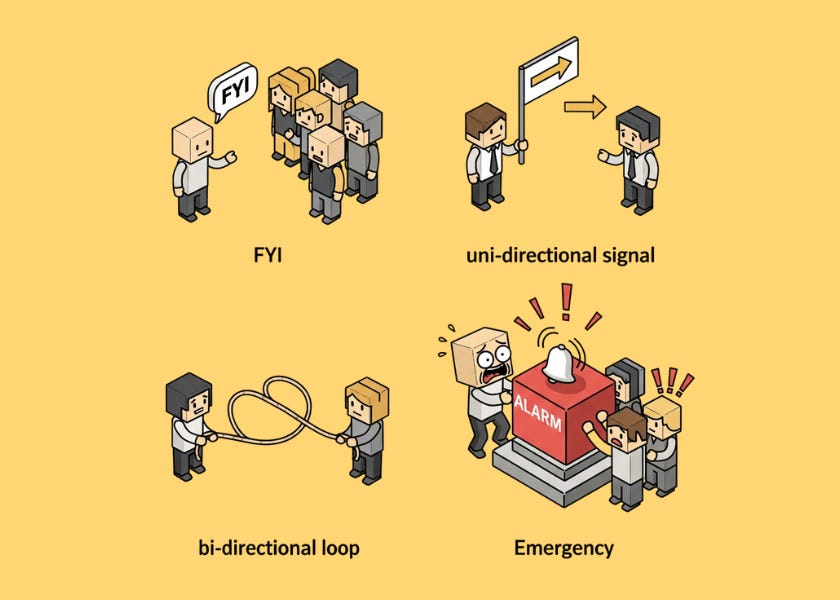Beyond "FYI": A Smarter Way to Share Information
Level up your async comms and collaboration with our relevance model
Do you feel like you're drowning in a sea of information? Unsure what to prioritize? Or perhaps you've sent out something crucial, only for it to be missed by the very people who you believed needed it most?
A client we worked with recently was facing this challenge in their leadership team and across the org. Our task was to offer a simple solution that could be used immediately, by anyone.
Happily, they liked what we shared so much that we suspected it might be valuable for other teams. So here goes…
Understanding Relevance Levels
When we think about group communication, we find it helpful to categorize information into four ‘Relevance Levels’, based on the action required by readers and the level of urgency…
Think of it this way: the more a piece of information will lead someone to make a decision, especially a consequential or disruptive one (particularly if it affects people outside their management scope), the more attention they should pay to it. And if those decisions impact others, there should almost always be a clear time limit for action.
A Quick Example in Action
To make this model concrete, let's consider a feature document outlining development work. Here's how different team members might engage with it based on their relevance level…
Charlie (Level 3 - Loop): As the Head of Product, Charlie needs ‘closed loop’ communication on this subject. This document might lead him to hit the brakes on development, a decision with significant group impact that he will need to reach and communicate promptly.
Janelle (Level 2 - Signal): As a member of the Bizops team, Janelle is receiving this information as an important signal. She might need to shuffle her own priorities to support the feature launch, a decision impacting her own work, perhaps with a less immediate but still present time sensitivity.
Ralph (Level 1 - FYI): Ralph from the Finance team treats this information as mere information-of-interest. He likes to stay informed about new releases but doesn't need to take any specific action. There's no time pressure on him to consume or respond to the document.
Taking a moment to consider these levels for your audience can make a huge difference in how your message is received and acted upon.
How Do We Signal Relevance?
The leadership team we were supporting were keen to understand how much work authors should do both to understand and then to communicate relevance levels. Our experience tells us that there are three main approaches…
Explicit, Per-Document Signalling: Imagine creating a table for every document that lists each person and their specific relevance level. This is the most work for the author, but it makes any misalignment between the author's and reader's understanding of relevance immediately obvious. It's incredibly clear.
Implicit, Per-Document Signalling: A step down in author workload. Here, the author ensures the purpose and scope of the document are crystal clear at the very top. Readers then self-identify their relevance level. While less work for the author, it puts the onus on the reader to perform triage, and it's much harder to spot when an author and reader are on different pages about relevance.
Implicit, Per-Channel Signalling: The least work for everyone. This involves setting blanket defaults for specific communication channels. For example, "Anything shared in the 'Urgent War Room' Slack channel means everyone is a Level 4 – no debate". While efficient, readers can become "jaded" over time if such a channel frequently sends out less urgent information, leading to decreased engagement. It also shares the same misalignment challenge as the implicit, per-document approach.
You can, of course, imagine subtle variations, like applying defaults for certain people in specific circumstances. The key is finding what works best for your team and context while keeping things as simple as possible.
What Happens When Things Go Wrong?
No system is perfect, and we identified two main "failure modes" when it comes to signalling relevance…
Level Misalignment: This is when you think someone is a Level 3 (needs to act on it with group impact), but they perceive themselves as a Level 1 (just an FYI). This can lead to missed actions and frustration.
Lack of Time-Limit Discipline: Even if everyone agrees on the relevance level, problems arise if deadlines aren't communicated or if recipients fail to acknowledge they can't meet them. If you have a level 3 communication, for example, you need to provide a clear timeframe for looping back, and the recipients need to take accountability for that action.
How Deliberate Is Your Team?
As we mentioned above, we’ve shared this model because this is an area where we repeatedly see teams struggle. When there isn’t strong alignment around the relevance and expected reactions to asynchronous communication, that communication drifts into uselessness.
With that in mind, is this something you think could add value in your team/org?
If the answer is “yes”, one key promoter of success will be to have a clear experimentation approach. Authors who go the extra mile implied by this model need not only to make sure the communications loops are closed with people at higher relevance levels but that they’re also seeking feedback from a sampling of all recipients.
Having a list of standard questions that you ask over and over again will give you a good iterative baseline as you try to get the right process for the right people…
How often are authors getting the relevance level right?
When they aren’t, why not … and are any patterns emerging?
When does channel-based level-setting work and when is it failing?
As ever, if you do decide to give it a try, we’d love to hear from you in the comments (or hit reply). And please do give this a heart if you found it useful so others can find it too 🙌



